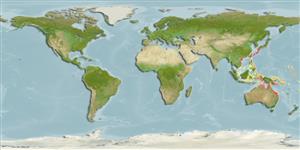>
Ovalentaria/misc (Various families in series Ovalentaria) >
Pomacentridae (Damselfishes) > Microspathodontinae
Etymology: Parma: Latin, parma, -ae = a little shield.
More on author: Whitley.
Environment: milieu / climate zone / Tiefenbereich / distribution range
Ökologie
seewasser riff-verbunden; standorttreu; tiefenbereich 2 - 20 m (Ref. 7247). Tropical
Western Pacific: eastern Australia between Cape Tribulation, Queensland and Sydney, New South Wales.
Size / Gewicht / Alter
Geschlechtsreife: Lm ? range ? - ? cm
Max length : 16.5 cm SL Männchen/unbestimmt; (Ref. 7247)
Kurzbeschreibung
Bestimmungsschlüssel | Morphologie | Morphometrie
Rückenflossenstacheln (insgesamt) : 2; Rückenflossenweichstrahlen (insgesamt) : 17 - 20; Afterflossenstacheln: 2; Afterflossenweichstrahlen: 13 - 15.
Body shape (shape guide): short and / or deep; Cross section: compressed.
Museum specimens indicate that this species is probably most abundant in non-coral reef coastal waters, although one specimen at the Australian Museum was taken at Great Island on the Great Barrier Reef, Australia. Life history characteristics for the family specify that this group is oviparous, with distinct pairing during breeding (Ref. 205). Eggs are demersal and adhere to the substrate (Ref. 205). Males guard and aerate the eggs (Ref. 205). Diurnal species (Ref. 113699).
Life cycle and mating behavior
Geschlechtsreife | Fortpflanzung | Ablaichen | Eier | Fecundity | Larven
Life history characteristics for the family specify that this group is oviparous, with distinct pairing during breeding (Ref. 205). Eggs are demersal and adhere to the substrate (Ref. 205). Males guard and aerate the eggs (Ref. 205).
Allen, G.R., 1991. Damselfishes of the world. Mergus Publishers, Melle, Germany. 271 p. (Ref. 7247)
IUCN Rote Liste Status (Ref. 130435: Version 2025-1)
Bedrohung für Menschen
Harmless
Nutzung durch Menschen
Tools
Zusatzinformationen
Download XML
Internet Quellen
Estimates based on models
Preferred temperature (Ref.
123201): 24.3 - 28.2, mean 26.9 °C (based on 680 cells).
Phylogenetic diversity index (Ref.
82804): PD
50 = 0.5010 [Uniqueness, from 0.5 = low to 2.0 = high].
Bayesian length-weight: a=0.01995 (0.00910 - 0.04376), b=2.99 (2.80 - 3.18), in cm total length, based on LWR estimates for this (Sub)family-body shape (Ref.
93245).
Trophic level (Ref.
69278): 2.7 ±0.24 se; based on food items.
Widerstandsfähigkeit (Ref.
120179): mittel, Verdopplung der Population dauert 1,4 - 4,4 Jahre. (Preliminary K or Fecundity.).
Fishing Vulnerability (Ref.
59153): Low vulnerability (10 of 100).
🛈
Nutrients (Ref.
124155): Calcium = 81.5 [41.5, 129.3] mg/100g; Iron = 0.655 [0.404, 1.069] mg/100g; Protein = 18.2 [17.1, 19.4] %; Omega3 = 0.101 [0.063, 0.161] g/100g; Selenium = 23.1 [13.1, 42.9] μg/100g; VitaminA = 83.2 [22.9, 279.6] μg/100g; Zinc = 1.59 [1.10, 2.29] mg/100g (wet weight);
